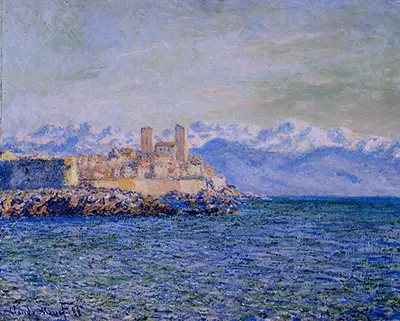The French Impressionists had made it their clear and stated intention to work in such a way as to evoke a feeling or impression of a time of day, a season or even a mood, and in the The Old Fort at Antibes, Monet manages to achieve all of this with a truly remarkable level of complexity and accomplishment.
The predominant blues and whites of the painting let the viewer feel the coolness of the Mediterranean sea in winter, while giving a sense of space and of light that is at once delightful and liberating. Monet had travelled from his home in Paris to spend time on the south coast of France in January of 1888, like so many of his contemporaries, in order to work in the unparalleled light of the region.
Although many of the impressionist works of the time were made during the summer months, The Old Fort at Antibes shows us the coast in winter. There is a coolness and sense of detachment in the vast grey blue sky and in the choppy ocean, reflecting no doubt many of Monet's own feelings of freedom, but also with the ever present sense of loneliness and isolation.
Like most of the impressionists, working outside in the open air was a key part of his process, and in this landscape, Monet is almost able to make us feel the breeze that he himself must have felt as he sat and worked.
Monet found the weather problematic in the winter of 1888 and would find he was simply unable to work on some days due to rain or winds, while on others he reported how he might work for days at a stretch without a problem.
The fort itself draws the viewer's eye to its solidity, contrasting with the ephemeral nature of the skies above the sea below, giving us something to hold onto in the scene. A significant part of the beauty of the painting lies in the way we are invited to consider the solid stone building that has stood on the same spot for hundreds of years, with the constantly shifting cloak of nature that surrounds it.
The sea itself is a masterpiece of Monet's unmistakable style, using a wide pallet of greens, blues, greys and even hints of rose to convey a breathtaking impression of the sea. The final result of the painstaking hours spent outside trying to capture the very essence of the South of France in winter provides us with a shimmering, vibrant work that stands out as one of the great examples of an impressionist painter at the very height of his powers.


